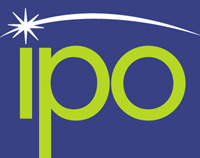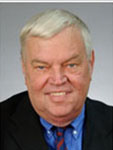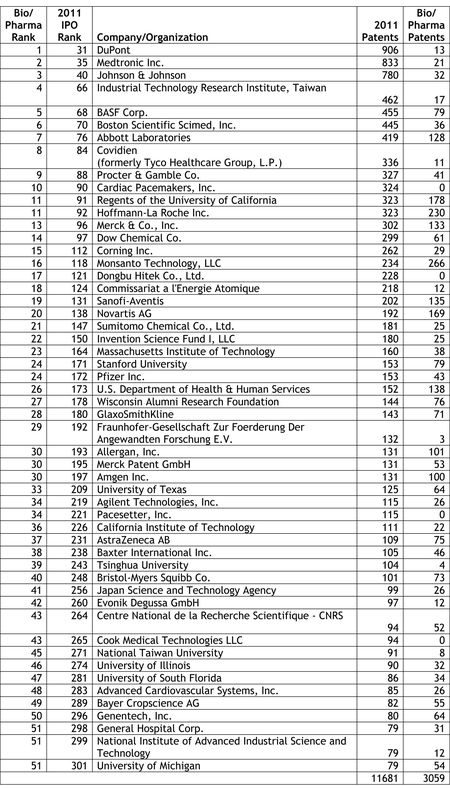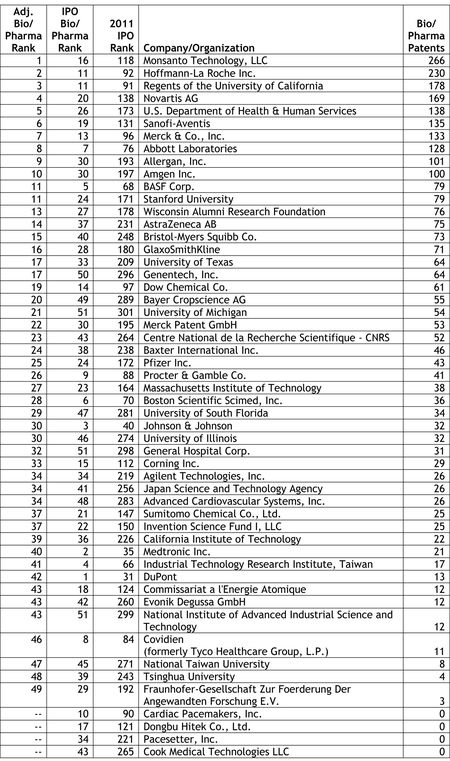[author: Donald Zuhn]
 Last week, we reported on the release of the Intellectual Property Owners Association's (IPO) list of the Top 300 organizations receiving U.S. patents in 2011 (see "IPO Releases List of Top 300 Patent Holders for 2011"). As in past years, Patent Docs used the IPO's list of top patent holders to compile a list of the top 53 life sciences companies and organizations receiving U.S. patents in 2011. Our analysis was not quite an exact science, as we noted that a number of companies and organizations appearing on the Life Sciences Top 53 are likely to be involved in work outside the life sciences sector, and therefore, that a portion of the patents granted to these companies and organizations are likely to be directed to other than life sciences-related inventions.
Last week, we reported on the release of the Intellectual Property Owners Association's (IPO) list of the Top 300 organizations receiving U.S. patents in 2011 (see "IPO Releases List of Top 300 Patent Holders for 2011"). As in past years, Patent Docs used the IPO's list of top patent holders to compile a list of the top 53 life sciences companies and organizations receiving U.S. patents in 2011. Our analysis was not quite an exact science, as we noted that a number of companies and organizations appearing on the Life Sciences Top 53 are likely to be involved in work outside the life sciences sector, and therefore, that a portion of the patents granted to these companies and organizations are likely to be directed to other than life sciences-related inventions.
 In a series of e-mail newsletters distributed last week, Hal Wegner (at left) reported on the IPO's Top 300 list, noting that the IPO's list was dominated by the electronics/software/manufacturing sectors, which grabbed the top ten spots on the list, and that the top ten bio/pharma companies averaged 288 patents, or "less than one-sixth that of the patent industry leaders." In comparing his own analysis with our Life Sciences Top 53, Mr. Wegner noted that our list was compiled using a broader definition of life sciences and his list resulted from a narrower focus on pharmaceuticals. In a follow-up e-mail, Mr. Wegner observed that "[t]he Top Ten pharma companies of the world average $35 billion in patent-secured sales, the most profitable use of the patent system amongst all industries."
In a series of e-mail newsletters distributed last week, Hal Wegner (at left) reported on the IPO's Top 300 list, noting that the IPO's list was dominated by the electronics/software/manufacturing sectors, which grabbed the top ten spots on the list, and that the top ten bio/pharma companies averaged 288 patents, or "less than one-sixth that of the patent industry leaders." In comparing his own analysis with our Life Sciences Top 53, Mr. Wegner noted that our list was compiled using a broader definition of life sciences and his list resulted from a narrower focus on pharmaceuticals. In a follow-up e-mail, Mr. Wegner observed that "[t]he Top Ten pharma companies of the world average $35 billion in patent-secured sales, the most profitable use of the patent system amongst all industries."
To get a more accurate picture of the top companies involved in bio/pharma patenting, we searched the U.S. Patent and Trademark Full-Text and Image Database for the number bio/pharma patents that were issued last year to each of the companies and organizations on our Life Sciences Top 53. The number of bio/pharma patents was determined by searching for patents designated as belonging to at least on of the following classes: 424 (Drug, Bio-Affecting and Body Treating Compositions), 435 (Chemistry: Molecular Biology and Microbiology), 436 (Chemistry: Analytical and Immunological Testing), 504 (Plant Protecting and Regulating Compositions), 506 (Combinatorial Chemistry Technology: Method, Library, Apparatus), and/or 514 (Drug, Bio-Affecting and Body Treating Compositions) that issued in the specified year. A search of the USPTO patent database for 2011 patents designated as belonging to one of the above classes indicates that of the 244,430 utility patents that were issued last year, 14,973 (6.1%) were directed to bio/pharma-related inventions.
After performing the above search for each of the companies and organizations on our Life Sciences Top 53, we obtained the following results (with bio/pharma patents -- i.e., those designating at least one of the above classes -- listed in the "Bio/Pharma Patents" column; click on table to enlarge):

As indicated above, the Life Sciences Top 53 secured a total of 11,681 patents, of which 3,059 (26.2%) were bio/pharma patents. Re-sorting the Life Sciences Top 53 by bio/pharma patents produced the following list (click on table to enlarge):

While each of the Top 10 bio/pharma companies and organizations from our LIfe Sciences Top 53 secured at least 100 bio/pharma patents in 2011, the 1,578 patents granted to the Bio/Pharma Top 10 constituted just over one-fourth of the number of patents issued to IBM in 2011 (IBM took the top spot on the IPO Top 300 list with 6,148 patents).
While our search produced a list that may be more indicative of the top bio/pharma patentees (at least among the top 300 patentees), it was probably limited in some respects. For example, to the extent that bio/pharma patents were designated in some other class, such patents would have been omitted from our count. In addition, to the extent that a subsidiary of a given company contributed to that company's patent count and the subsidiary had a distinct name, such patents would have been omitted from our count (the IPO notes that for its Top 300 list, patents in the name of a majority-owned company were included with patents of the parent organization if the organization asked the IPO to include subsidiaries). Moreover, if the assignee was not indicated on the face of the patent, that patent would have been omitted from our count. That being said, the IPO notes that for its Top 300 list, patents that were granted to two or more organizations jointly were attributed to the organization listed first on the patent document. In generating our list, such patents would have been included in both organizations' counts (this difference may explain why Monsanto was named as an assignee on 266 bio/pharma patents, but appears to have been granted only 234 patents on the IPO's list).